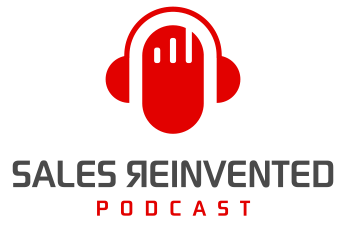Episode #416: Rex Biberston

Meet
Rex Biberston
Rex Biberston is the CEO of No Fluff Selling, a sales operations agency focused on building world-class sales orgs for their clients. He co-authored the best selling book, Outbound Sales, No Fluff and continues to share his experiences and learnings on LinkedIn while working with early and growth stage companies at NFS.
Our Mission Is To Change The Negative Perception Of Sales People
Our Vision Is A World Where Selling Is A Profession To Be Proud Of
According to Rex Biberston, as long as people still pick up their phones, there will be value in cold-calling. Obviously, it’s truer for someone where using the phone is a normal part of their workday. If they’re talking to customers daily, they’re likely still answering unanticipated phone calls.
That being said, there is a procedure and methodology to cold-calling that can make you more effective. The reality is that most of it can be learned and improved upon. Rex shares some of his expert tips in this episode of Sales Reinvented.
Outline of This Episode
- [0:52] What is cold-calling? Is it still relevant?
- [2:07] Is cold-calling an art and a science?
- [2:59] How Rex prepares for cold-calling
- [4:30] Rex’s opening lines and techniques
- [6:15] How to keep cold calls engaging
- [8:50] Tools and technology to leverage
- [10:53] How Rex measures effectiveness
- [12:39] The risks of using a parallel dialer
- [14:22] Rex’s top cold-calling dos and don’ts
- [17:10] How Rex faces objections/rejections
How to keep cold calls engaging
Rex believes that a call should be planned—but not fully scripted. You should know what you want to say to start the conversation, so Rex will ask 1–2 scripted questions. However, he points out that you can’t possibly script all of the potential scenarios that will arise from those questions. You owe it to the prospect to deliver an excellent conversation so you must practice, practice, practice.
Do you have something valuable or interesting to say to that person? That’s how you keep it engaging. The prospect will naturally keep the conversation going.
Rex does script his call to action: “Hey Paul, I appreciate your time and obviously I called you out of the blue here. It sounds like there’s a thread we should follow up on. Do you have time next Tuesday or Thursday where we could spend maybe 30 minutes diving a little bit deeper?”
Tools and technology to leverage
The tools and technology you use depend on your company and the size of the target market. For midsize to large markets, Rex likes using parallel dialers (like Nooks.ai). They drop you right into live conversations. You don’t have to pick up the phone and manually dial numbers.
Are there any risks to using a parallel dialer? If you haven’t done a good job building your list in a way that makes sense, it’s quite risky. You can’t jump between a cold list of VPs of sales and a cold list of CROs, etc. You’ll sound like an idiot. You have to prepare an intelligent list.
Nooks and many other tools now offer practice calling with AI. You can build out a persona and practice real-time responses as if they were the buyer. It’s becoming indispensable.
How Rex measures effectiveness
The outcome of high quality conversations should be scheduled meetings. He measures:
- The dial-to-connect rate: How often did you actually talk to someone who was the named contact on record? Most organizations see a 3% rate.
- The connect to conversation rate: How often do you get past 30 seconds?
- Conversation to conversion rate: This typically means scheduling a meeting.
However, If you verify they use the phone number you’re calling, have a positive or even neutral interaction with them, and know you can call them down the road when they’re in the market, it’s a positive outcome. You can follow up down the road.
How Rex faces objections/rejections
You don’t just have one chance to make a first impression. Rex points out that most people you call today won’t remember you tomorrow. Most won’t remember you in a month. It’s okay to come out of a conversation without a meeting.
If he hears an objection he isn’t prepared for, he’ll write it down, tackle it in his scripting, and be better prepared the next time. He doesn’t mind being rejected as long as he knows why. Is it something he could improve? Did he provide value? What could he do differently next time?
Even a negative outcome doesn’t always mean you can’t call them back down the road. Someone may just be having a bad day.
Connect With Paul Watts
Audio Production and Show notes by
PODCAST FAST TRACK
https://www.podcastfasttrack.com
Learn More About Rex Biberston
What was a pivotal moment or experience in your career that shaped your approach to cold calling, and how did it change your perspective or strategy?
At my very first BDR role at my first tech company I spent a week in onboarding and none of it covered cold calling. When I sat down at my computer for the first day on the phones I was handed a paper copy of a script by my manager who told me, “This is the only script you’ll ever need.” The other reps on the team were barely making quota most months and I knew that many of them were following that script. I instead dedicated myself to daily iteration on the script until I had a version that worked so well for me I would set all my meetings in the morning and spend the rest of the day learning about email, LinkedIn, and our product. That consistent commitment to improving my work made me a better BDR and I carry that lesson with me to every team I work with.
Can you share a specific tactic or approach you’ve used in cold calling that significantly increased your success rate? Please provide a brief example or case study.
I call it coming to the call with a PLAN not a script. Most people fall into one of two camps: They use scripts and tend to sound uncomfortable and robotic because they don’t practice enough OR they hate scripts because they don’t want to sound robotic. I prefer to script just three parts, creating more of a PLAN on how to navigate a conversation than a step by step guide I have to unnaturally follow:
- I script my intro so I can consistently iterate on it until nearly every conversation is over a minute (meaning I’ve actually gotten to pitch something). I then have a value prop that I use to explain why I’m calling in a more useful way to the prospect. It’s essentially my hypothesis about the pain they’re likely dealing with.
- I script 1-2 conversation-driving questions that get the prospect to give me some intel about their company and personal priorities. This leads to a healthy back and forth in most cases rather than something I follow in a scripted format. I can’t predict what they’re going to say, so I don’t try.
- I script my call to action so I have something to fall back on when we’ve had a good conversation and I can’t afford to take up more time digging further.
Here’s an example:
#1: Hey John, it’s Rex with No Fluff Selling. I called to see if what we do to raise sales KPIs could benefit your team. Did I catch you with two minutes?
#2: Great! So we work with founder-led sales teams like yours to bring in a set of best practices that we’ve seen typically generate between 2 and 3 times more sales conversations and ultimately revenue.
#3: I imagine you’ve got your eyes on a goal for your team this quarter. What’s the KPI you’re most focused on with them? Meetings? Closed won business?
[I now have a regular human conversation about their answer.]
#4 Well listen John, I called you out of the blue but it sounds like we ought to follow this thread a little further. Do you have a half hour next Tuesday or Wednesday to continue the conversation?
Cold calling often comes with its set of challenges and rejections. Can you share a particularly tough challenge you faced while cold calling and how you overcame it?
The toughest challenge in my opinion is a prospect who shuts you down immediately because (a) they don’t take cold calls (b) they’re having a bad day (c) you screwed up your intro and didn’t even get to your value prop.
The secret is that I don’t try to overcome this in the moment. I can’t convince a short-tempered person to give me another shot right now. But now I know they pick up their phone. So I can set a task to call them in a week and make a note of which pitch I used so I can try a new angle. I may even spend some time researching ahead of the call so I can come in with something personalized to them that’s more likely to resonate, especially since I know they’re more likely than the other 100 people I call today to actually pick up the phone (since they have once already).
What are the top three tools or resources (e.g., software, books, training programs) you consider essential for someone looking to improve their cold calling skills and outcomes?
I don’t come from a highly-trained background. I learned through iteration and testing. There are some fundamentals available in the book I co-authored, but the best way to learn is to take the scientific method approach: hypothesize, test, observe, iterate.
One great new technology is AI-based call practice. You can use tools like Nooks and Hyperbound to create custom personas that can actually talk to you and let you practice on a live audience that isn’t a rep sitting next to you or on Zoom with you. It’s way more realistic and super powerful at getting repetitions in.
How do you foresee the practice of cold calling evolving in the next few years with advancements in technology and changes in buyer behavior? What advice would you give to sales professionals to stay ahead of the curve?
As long as people pick up the phone, the ability to speak well about a product and introduce it to buyers will be valuable. The foundation of great cold calling is a set of skills that can be transferred to many other roles throughout a person’s career, so even if the medium changes, the value of being a great communicator in front of strangers is high.
Share This Episode, Choose Your Platform!
